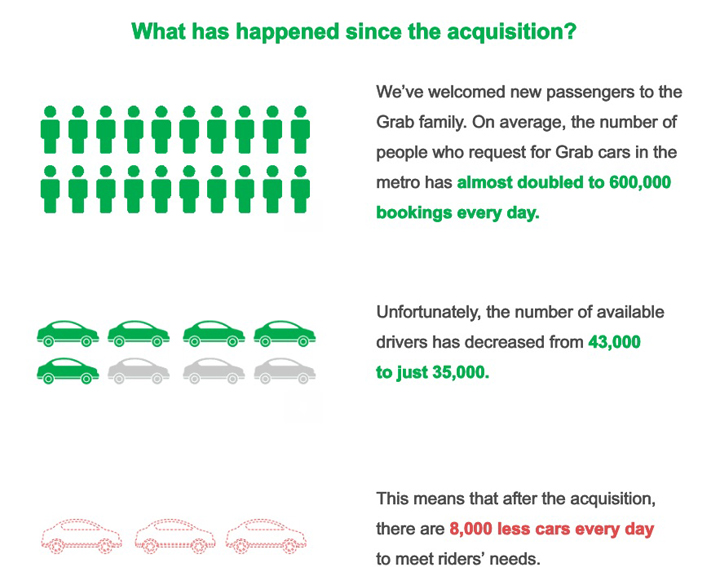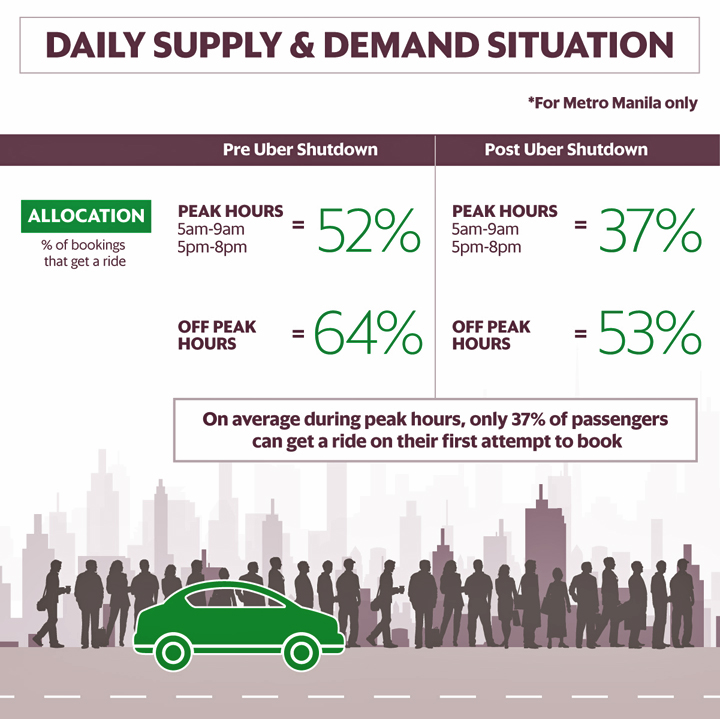According to Grab Philippines, their ability to improve their TNVS service to passengers in Metro Manila rests in the hands of the LTFRB. There are fewer Grab cars on the road because (1) 10,000 additional cars are still pending LTFRB approval and (2) low fares (due to regulatory restrictions) are disincentivizing active Grab drivers (they face longer work hours to make ends meet, and waste time and money on distant pickups). Right now, only 35,000 Grab cars are allowed to serve 600k daily bookings (on rainy days, that number reaches 850k). There are not enough Grab cars on the road, and it’s not Grab’s fault. “LTFRB,” said Grab Philippines Head Brian Cu, “has not done its part to solve the supply crisis.”
https://www.facebook.com/GrabPH/photos/a.537208633002150/1979659745423691/?type=3&theaterThe decline of TNVS car supply – a quick history
In January 2018, the LTFRB ordered a 45,000 common supply base of TNVS cars (less than a third of the 125,000 operating at the time). In February 2018, that base was raised to 65,000. The LTFRB (with data from a third party, Uber, and Grab) created a list of 55,000 vehicles, which became the basis of the official masterlist for processing CPCs and PAs.
After that, only 42,000 active vehicles were left in the system – that’s a 13,000 gap from the vehicles in the masterlist. Out of this, an estimated 35,000 (or less than 83%) were active. When Uber was acquired by Grab in March 2018, an estimated below-50,000 vehicles were active (out of which 43,000 were active – 24,000 from Grab and 19,000 from Uber).
When Uber drivers were transitioning to Grab, it was discovered that around 6,000 Uber vehicles were not included in the masterlist, were not allowed to transfer to Grab (or any other TNC) as per LTFRB decision. Making matters worse for ride-hailing passengers, 2,000 vehicles (their owners) chose not to join Grab.
The result is the deficit in cars we have now: 35,000 drivers (24,000 from Grab and 11,000 now-Grab-but-formerly-with-Uber) serving 600,000 bookings per day.
LTFRB is sitting on 10k TNVS slots
While Grab and other TNCs have been asking LTFRB to open the remaining 10k slots, LTFRB neither offers assurance of approval (of the 10k TNVS drivers) nor a mechanism to replace inactive cars. What are they waiting for? There are only 35k drivers serving 600k bookings daily – Grab’s ability to allocate cars is down by 40% (the lowest in Southeast Asia), that means allocation for only 4 out of 10 passengers. This, despite the Philippines’ being one of the first ride-sharing adopters in Asia, and the first to regulate ride-hailing in Asia in 2015.

#GrabOff: why the number of active Grab drivers are dropping
The suspension of Grab’s P2 per minute travel time charge reduced drivers’ income and resulted in the number of online drivers dropping by 6% from April to July 2018. Lower income meant that drivers had to work longer hours to make ends meet. Also, time and money are wasted on distant pick up points and passenger-cancelled bookings.
As a quick background, the LTFRB was compelled to suspend Grab’s P2 per minute travel time charge on April 2018, because of one lawmaker’s allegations that are misinformed since:
- the P2 per minute travel time charge has been applied by Grab since July 2017 (and by Uber since inception), the same month the fare was presented to the LTFRB in a working group meeting;
- the P2 per minute charge was legal: (1) pursuant to the DOTR DO 2015, TNCs (at the time) could set their fares with LTFRB oversight; and (2) Aileen Lizada an LTFRB board member, asserted the legality of the P2/ minute charge in a dissenting opinion she published to contest the P10m fine.

Grab tries to improve TNVS service with Grab’s 100-Day Plan
Despite these setbacks, Grab Philippines has been trying. As we wrote elsewhere: “These [efforts] include Improved Driver Behavior (incentives to top performing drivers, driver code of conduct, Grab driver academy), Better Ride Experience (more intuitive interface on the iOS and Android Grab app, easier redemption of offers, emergency dial-911 feature), Upgraded Customer Support (scaling up of customer service team, reduction of response time, dedicated service lines for passengers, drivers, and platinum users), and Driver Welfare Program (drivers can qualify for perks like discounts on gas and preventive maintenance).”
However, none of these result in increasing the number of TNVS cars on the road and in offering Grab drivers financial incentives to keep driving. Grab can only do so much.
End the Wait
Now you know why it’s so hard to book a Grab ride. Grab wants to increase their fleet so passengers can get to work, meet up with their friends, go home to their loved ones. Grab wants to incentivize their drivers so they’d keep driving and serving the Metro Manila riding public. The LTFRB can grab this chance to ease the commuting woes of the public. But will they?
Update Aug 29, 2018:
LTFRB said they will open 10,000 slots for TNVS franchises and will start a crackdown for colorum (TNVS vehicles with no PAs or CPCs) starting September 1. LTFRB started accepting TNVS applications from those not in the Masterlist on August 24. Meanwhile, August 31 is the LTFRB’s deadline for those in the Masterlist to apply for CPC or renew their expired PAs.
Despite these, Grab maintains that
- Immediate processing of slots will ease the supply problem and help get more people to their destinations.
- LTFRB must clean up the Masterlist by removing dormant drivers from the list. 13,000 slots are taken by inactive drivers, which, if replaced by active drivers (awaiting accreditation) can help meet the more than 15,000 rides daily (about 12 rides a day per driver).
- LTFRB should review the supply and demand situation every 3 months to check if the supply cap should be increased. This is because (1) not all drivers are full-time (some drive for only a few hours per week); (2) 20% of drivers are affected by coding and their other needs; (3) demand keeps growing as more people download more TNVS apps; and (4) erring drivers and operators banned from operating TNVS count as inactive and must be replaced.
Grab has also launched the #EndTheWait campaign to spread the word on the supply issue and it can be resolved.
Liked this post? Follow SwirlingOverCoffee on Facebook, YouTube, and Instagram.

